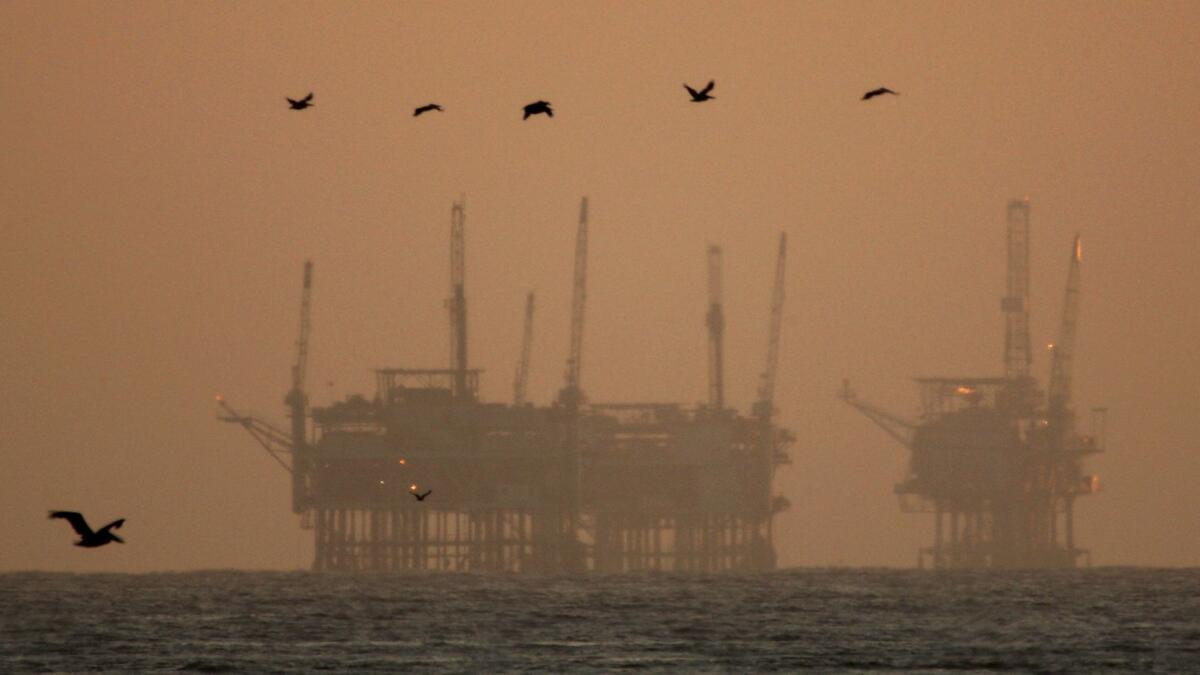Editorial: An energy bill that’s bad for marine mammals and most everything else on the planet

For decades, environmental activists in California have battled to keep the oil and gas industries from turning the state’s coastline into a West Coast version of the Gulf of Mexico oil fields. Their allies in Congress and, occasionally, the White House have helped their cause by placing (temporary) constraints on oil and gas leases, enacting the Marine Mammal Protection Act, and designating national marine monuments that protect swaths of ocean water from any kind of drilling. These are all sensible, smart restrictions designed to allow the oceans and the animal and plant life within them to thrive — while safeguarding the vulnerable coastline from the sort of spill that dumped 21,000 gallons of crude oil into the waters near Santa Barbara in 1969.
So it’s disturbing to see a bill in the House of Representatives that would upend many of these protections and functions as little more than a wish list for the oil industry. HR 4239, the SECURE American Energy Act, would strip the president’s ability to designate a national marine monument that’s off-limits to drilling, remove crucial protections for marine mammals, ease regulations on exploratory drilling in the Arctic region, and mandate the sale of offshore wind leases off the coast of California within a year of the bill’s passage.
Written mainly by lawmakers from Gulf Coast states, this toxic bill has made it through the House Committee on Natural Resources and may reach the House floor as soon as next week. It should be voted down, but in this House, it probably won’t be.
It’s worth noting that President Trump waged a lengthy battle in court against a proposed wind farm off the coast of one of his Scottish golf courses.
One of the most egregious aspects of the bill is that it strips away crucial safeguards in the Marine Mammal Protection Act for whales, dolphins and other ocean dwellers that are profoundly affected by the noise of seismic equipment used for oil and gas exploration. Underwater sonic discharges can, at their worst, damage the hearing of animals so badly that they lose their ability to navigate, which is essential to their survival, numerous experts say. The repeated air gun blasts into the water also disrupt feeding and reproduction. The Marine Mammal Protection Act makes it illegal to harm or kill a marine mammal without a permit, even if done inadvertently. Those permits are issued when companies can show that their work will impact only small numbers of animals. The law also requires energy companies to use methods that have the “least practicable impact” on marine mammals.
The new bill would remove those protections, while also exempting permitted activities from having to comply with the Endangered Species Act’s protections for endangered or threatened marine mammals. That’s nuts.
In another troubling provision, the bill would bar the president from designating a national marine monument to protect marine areas of national interest and significance from oil and gas drilling. Any future designation would instead require an act of Congress.
A third problem is the bill’s requirement that the federal government sell wind leases off the California coast within a year of enactment. While wind farms can be a good source of renewable energy, they are just starting to be sited in the ocean — with none yet off the coast of California. Wind farms should not be arbitrarily rushed into existence, as this bill would do.
In fact, the California Coastal Commission — which has authority under the federal Coastal Zone Management Act to weigh in on offshore activities — is already part of a multi-agency task force, led by the federal Bureau of Ocean Energy Management, working to identify the best locations for offshore wind farms. These offshore arrays of wind turbines are tethered by cables to the ocean floor and then connected to power stations onshore. To find environmentally suitable locations, the task force considers such factors as the wind farms’ effects on bird migration and ocean life, their appearance, and the impact of the onshore facilities on the surrounding areas.
It’s worth noting that President Trump waged a lengthy battle in court against a proposed wind farm off the coast of one of his Scottish golf courses in Aberdeenshire, arguing that it would spoil the view. (He lost.)
Even if this bill became law and a wind lease were quickly sold, there’s no guarantee that the project would ever be built. The Coastal Commission could find that it would have an adverse effect on sea birds and migrating whales, for example, and refuse to issue permits for the onshore component of the wind farm. The developers would probably then take the commission to court. So much for fast-tracking wind leases.
There’s so little good in this bill, lawmakers need to deep-six it. The environmentally unfriendly House isn’t likely to do so, but the Senate can and should.
Follow the Opinion section on Twitter @latimesopinion or Facebook
More to Read
A cure for the common opinion
Get thought-provoking perspectives with our weekly newsletter.
You may occasionally receive promotional content from the Los Angeles Times.










